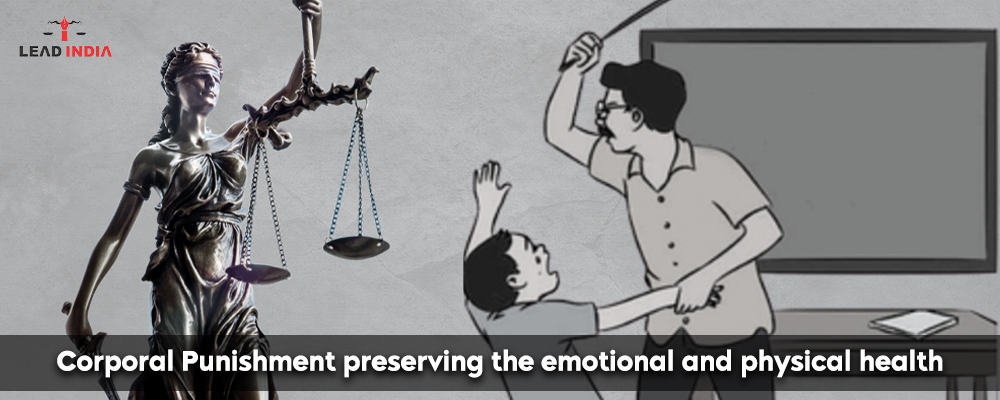The United Nations Committee on the Rights of the Child defines corporal punishment as “any punishment in which physical force is used and is intended to cause some degree of pain or discomfort”, however light.” According to the Committee, this usually entails beating (smacking, slapping, spanking) youngsters with a hand or tools such as rods, belts, and so on. The World Health Organisation (WHO) reports that corporal or physical punishment is widely used in both families and schools around the world. Approximately 60% of children aged 2 to 14 get physical punishment regularly from their parents or other carers. In India, there is no formal definition of ‘corporal punishment’ for minors.
Need A Legal Advice
The internet is not a lawyer and neither are you. Talk to a real lawyer about your legal issue

Types of corporal punishment
The types of corporal punishment are primarily grouped into two basic categories:
- Domestic corporal punishment: This is also known as parent-imposed child punishment. This can include smacking, spanking, or slapping. Many countries have forbidden this practice, and Sweden was the first to do so in 1979. However, it is still allowed in other nations, albeit subject to various legal restrictions. Restrictions, such as not hitting on the head and specifying an age restriction for inflicting penalties, have been enforced.
- Institutional corporal punishment: Many youngsters encounter corporal punishment in institutions such as colleges and schools. When a teacher fails to regulate a child’s behavior, he or she loses his or her anger and resorts to corporal punishment. We’ve been hearing about similar instances from time immemorial. Often, this surpasses the limit, resulting in serious injury to the youngster.
Consequences of corporal punishment
- When parents employ corporal punishment tactics to regulate and manage their children’s behavior, they are teaching their children that this is acceptable behavior and a way to resolve issues. These children grow up to be angry and more inclined to hit and beat their children using the same approach.
- When children are punished corporally, they become more aggressive and destructive. They are more likely to have low self-esteem, anxiety disorders, despair, and suicidal thoughts, as well as emotional scars that will last their entire lives.
- When children experience grief, fear, wrath, and humiliation, they also feel threatened, which activates a brain pathway that causes physiological stress.
Preventive precautions against physical punishment
- Norms and value programs will be implemented to modify these negative social norms around child rearing and child discipline.
- Laws will be enacted to ensure that children are as safe from assault as adults and to raise awareness. There is a need to modify mindsets towards nonviolent child rearing, and parents must recognize their responsibility.
- To instill in parents a nonviolent and caring character, information and skill-building programs should be held.
Case Laws
- In Ambika S. Nagal Vs State of Himachal Pradesh, 2020, the State High Court ruled that parents must provide an implied agreement for their child to be punished and disciplined in school.
- In a 2014 case against the State of Kerala, Rajan Vs Sub-Inspector of Police, the Kerala High Court upheld corporal punishment, stating that it was beneficial to the child even in cases where the consequences were severe because the teacher has the authority to inflict the punishment.
Corporal punishment has been prohibited in many nations, yet it is still used behind closed doors. Some countries, however, authorize some form of corporal punishment. But who can decide how much force is appropriate for disciplining a youngster through corporal punishment? No one can determine, and this is most likely why we continue to witness incidents where professors almost lose their cool and violently discipline students. As a youngster grows older, he or she experiences a variety of moods and zones. They may be struggling with several challenges.
People in our society continue to believe in the age-old custom of “spare the rod, spoil the child,” and end up punishing their children unreasonably. The Indian government has prohibited corporal punishment across the country. However, the regulations of the UN Convention on the Rights of the Child treaties have not yet been implemented at the school or student level. Corporal punishment is still used in schools and homes today. Developing countries have implemented initiatives to raise awareness about corporal punishment and its consequences on children’s mental and physical health.
Lead India offers free legal advice and online information, in addition to other legal services. We provide a forum to speak with a lawyer and ask legal questions. Lead India’s solicitors can help you with any legal difficulties. Lead India’s solicitors may assist you with any legal issues. Lead India also provides free online legal help in India. In addition to giving online legal assistance, Lead India allows users to ask specialist questions for free.





 Talk to a Lawyer
Talk to a Lawyer